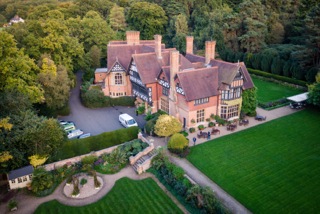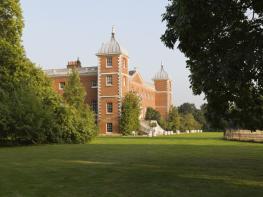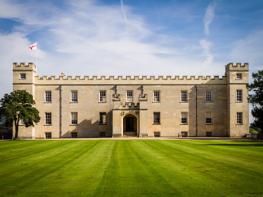Park Plaza London Park Royal is situated within easy reach of Heathrow Airport and Wembley,…
Over the hill at Horsenden

2.75 miles (4.4kms)
About the walk
The summit of Horsenden Hill sits 276ft (84m) above suburban west London, making it one of the highest points in the capital. It is also the largest open space in the Borough of Ealing and at one time this area was dense woodland where wild boar, bears and wolves roamed. If you like a hill to be a hill and want a steeper uphill walk for a better workout, do this route in reverse.
Heading for colour
The best time to see the diversity of wild flowers and invertebrates, such as butterflies, is from June to August, when the hill is transformed into a landscape of colour. Small copper and common blue butterflies are often seen in the area by the series of steep steps leading down to the solitary oak tree, because their caterpillars like to feed on plants from the dock and pea family, which grow here in abundance. Dyer's greenweed also thrives here, although the plant is quite scarce in London. Its yellow extract was once used to dye cloth and was mixed with a blue extract from the wood plant to make a green dye.
The grasslands here have simply been left to develop naturally, first by grazing and then by hay cutting. In this way, wild flowers have prospered.
Conservation in the woodland
The traditional methods of cultivating the land also extend to the woodland. A good example of this is the ancient Perivale Wood, which becomes a sea of bluebells in spring. As you walk along the canal beside the wood you may notice that it provides a habitat for beetles and other insects. It makes a good nesting area and food supply for birds, too. Lichen growing on some of the tree trunks is an indication of good air quality because the organism, a mix of algae and a fungus, can only grow successfully in clean air. Felling trees is an important part of woodland management since it means that trees do not have to fight for light. One conservation technique carried out is the old craft of hedge laying. The slim trunks of the hedging trees are partly cut (but not severed), then bent over to allow new growth to appear from the stump. The extra sunlight allows flowers such as cow parsley and red campion to grow at ground level.
Walk directions
From the car park walk back towards the road. At the metal barrier turn right down some steps and continue along a tarmac path that runs parallel to Horsenden Lane. Continue in front of the Ballot Box pub to reach a tarmac path just past it.
Turn right along this treelined path and keep ahead as it passes Ridding Wood on the left. After 0.25 miles (400m) turn right, just before a metal gate and a row of houses, to enter Horsenden Wood.
Within a few paces take the left-hand path at a fork and keep ahead as it climbs steadily uphill then crosses a tarmac path. Bear right at the row of trees ahead of you that marks the boundary of the golf course. From the top of the hill are panoramic views stretching as far as the North Downs, Windsor Castle, the Chiltern Hills and Harrow-on-the-Hill.
Take the footpath to the right of the triangulation pillar towards the red-topped post. Be sure to glance left through the gap in the trees for a superb view of the Wembley Stadium arch. Descend a flight of steep wooden steps through a thickly wooded area. Keep going all the way to the bottom, veering right where paths meet, until you come to a meadow that is fenced off and entered by a stile with two red-topped posts. This is used for seasonal cattle grazing (as indicated by signs), so take the usual precautions if animals are in this part of the field. Pass the solitary large oak in the middle of the meadow, go through a kissing gate, down more steps, turn left along the road and pass a sign to the Horsenden Visitor Centre on your left.
Continue ahead crossing a footbridge over the Grand Union Canal (Paddington Branch). Now turn left again, down steps, to the tow path. Continue under the bridge along this peaceful stretch of the canal, which later widens and passes Perivale Wood.
Keep walking straight ahead for another 0.3 miles (480m). Turn left after the wooden footbridge to go through a kissing barrier and go right to cross the Grand Union Canal again. Carry on ahead and Horsenden Hill is now visible in front of you. Follow the winding footpath to go through another kissing barrier.
Turn left along a gravel path to the right of the playing field and, when the path divides, keep ahead past a second playing field. When the path swings left, go right through the gap in the trees and bear diagonally left across the large field towards the Ballot Box pub. Cross the road and turn right to retrace your steps along the tarmac path to return to the start.
Additional information
Mainly woodland tracks
Wood, meadows, tow path and extensive views
No particular problems
OS Explorer 173 London North
Car park at Horsenden Hill
None on route
WALKING IN SAFETY
Read our tips to look after yourself and the environment when following this walk.
Find out more
Also in the area
About the area
Discover Greater London
Greater London is one of the world’s largest urban areas; 33 boroughs stretching north to Enfield, south to Croydon, east to Havering, west to Hillingdon and with central London at the heart of it all.
Greater London was officially created in 1965, but the boroughs themselves all have their own histories going back much further. Greenwich is home to the Prime Meridian, which all clocks on earth take their time from, while Hounslow contains Heathrow Airport, one of the busiest airports in the world. Greater London contains a multitude of parks and green spaces, from the six Royal Parks (including Richmond Park, Green Park, Hyde Park and Regent’s Park) and other huge open spaces like Hampstead Heath and Clapham Common; to smaller community spaces like Clissold Park in Stoke Newington and Burgess Park in Southwark.
The centre of London has its quiet spaces too, like Coram’s Field by Great Ormond Street, and Camley Street Natural Park, a stone’s throw from King’s Cross and St Pancras. One of the city’s most impressive features is the London Underground. Beginning in 1863 as the Metropolitan Railway, it took commuters into The City from the suburbs of Middlesex. It was the first underground railway in the world, and now consists of 11 lines, 270 stations, and 250 miles (402km) of track. It’s estimated that nearly five million journeys are taken every day, and there are nearly one and a half billion riders each year. At peak times, there are more than 543 trains whizzing around the Capital.
Nearby stays
Restaurants and Pubs
Nearby experiences
Recommended things to do
Why choose Rated Trips?
Your trusted guide to rated places across the UK
The best coverage
Discover more than 15,000 professionally rated places to stay, eat and visit from across the UK and Ireland.
Quality assured
Choose a place to stay safe in the knowledge that it has been expertly assessed by trained assessors.
Plan your next trip
Search by location or the type of place you're visiting to find your next ideal holiday experience.
Travel inspiration
Read our articles, city guides and recommended things to do for inspiration. We're here to help you explore the UK.













